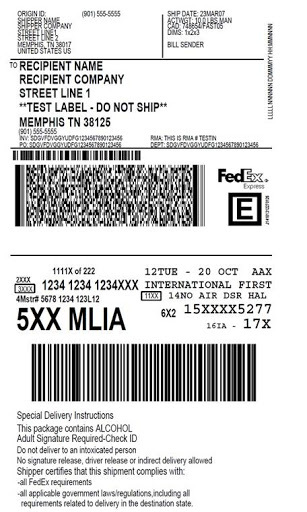Time is a precious business resource. Quicken your regular, everyday business processes, and more time becomes available to focus on your company’s bustling growth. Shipping labelling is a core, time-consuming aspect of order fulfilment, making its efficiency hugely important.
In this article, we’ll walk through the requirements of a shipping label, and some effective methods for creating and printing them.
What Are the Requirements of a Shipping Label?
Shipping labels contain crucial information that allows the shipping courier to deliver the parcel accurately and efficiently. This is a list of typical information that can be found on a shipping label:
- Customer’s ship to address
- Company’s return to address
- Unique delivery instructions, such as leave at front door
- Signature requirements
- Connote number
- Article number
- Scannable barcode
- Package weight
- Whether postage has been paid
Much of this information is mandatory for shipping courier labels, and it varies between couriers, who often have incredibly strict requirements. The information displayed and the layout of the label is unique for every single courier—if information is missing or incorrectly positioned on the label, there’s a chance that the courier will refuse to deliver the parcel, resulting in costly charges. It’s essential that the shipping label template meets the necessary requirements for each courier.
Here’s a couple of shipping label examples for couriers:


The industry standard size for a shipping label is 4x6 inches. For smaller packages, it might be possible to use a 6x3 or 4x4 inch label, but this depends on the courier. Labels cannot be reused, as each of them contains unique information related to the order.
How to Print Shipping Labels
There’s a few different ways to create and print shipping labels, each more effective than the last.
1) Write them yourself
At the bare minimum, you can write your customer’s address on a sticky label, add it to your parcel, and take it to your local post office for shipment. This is obviously the slowest way for you ship orders, but also doesn’t require any understanding of complex courier shipping labels, or payment for shipping label software.
2) Use a courier’s online label template
Many couriers offer an online service where you can create and print a shipping label. Typically, you’ll need to visit their website, manually fill out the customer details, download the label, and then print on a sticky label with a thermal or laser shipping label printer.
As all elements are catered for, this technique guarantees a correct label layout for the courier, but can be tedious if you’re processing lots of daily orders, in addition to being vulnerable to human error, with the potential to damage your brand’s image, and lose future sales.
You can find some popular online courier services here:
3) Use third-party shipping labelling software
There’s a few software options available for printing your shipping labels, but the downside is having to import your orders into the system every time you want to print (unless the software has an automatic import tool, or an API).
ShipStation and Easyship are popular choices for this method, but come with a monthly cost.
4) Use fully integrated software
This is the method with the biggest time and cost savings—fully integrated ecommerce software that allows you to both receive and ship your orders, with shipping labels available for your chosen courier. There’s no exporting and importing required, it’s easy as clicking the print button for an order (or a selection of orders).
Neto allows you to do this through our quick and easy Neto Ship add-on—there’s no need to log into external software, you can just print your shipping labels from within the platform itself, which acts as a shipping label generator. Neto integrates with all of the major Australian shipping couriers, in addition to FedEx and UPS in the United States. Also, Neto enables you to package orders into pre-defined cartons, and then print the correct number of shipping labels for each carton.

The couriers’ shipping label format and the customer’s details are already in the system, so there’s no chance of human error. There’ll be no label sizing issues, no missing information, and so no costly re-sending of packages. There’s also a good chance of saving on staff costs, with significant time freed through quicker order processing.
Being able to process and ship orders more quickly means that your customers will receive their goods faster—a huge bonus when competing against the likes of delivery speed demons Amazon.
| Related Reading: How Should I Charge For Shipping?
---
You don’t have to waste precious hours manually printing shipping labels—a fully integrated software solution can accelerate your order processing, freeing up valuable time for you to concentrate on your company’s prosperous growth.
